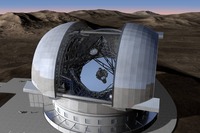Europe Downscales Monster Telescope to Save Money | ScienceInsider
The world’s biggest telescope is getting smaller—but more affordable. The designers of the future European Extremely Large Telescope (E-ELT) have decided to shrink the telescope’s primary mirror from a diameter of 42 meters to 39.3 meters. The resulting 13% decrease in sensitivity is likely to reduce its scientific payoff. But the 18% savings in its overall cost gives the telescope a better chance to remain on schedule for first light in 2022.

The real story here is that Europe is moving ahead at a good pace, while the US community is still bitterly divided over two competing projects, neither of which has the federal support that appears increasingly necessary to firm up international partnerships.
I have recently heard that the Canadian community is getting so frustrated with the slow pace of progress on the US side, that if the situation doesn’t improve relatively soon, Canada is considering withdrawing from TMT to go join ESO and E-ELT. Yow. It doesn’t look good, especially since supposedly NSF AST doesn’t even have the funds to conduct a downselect study between TMT and GMT, much less financially support whichever is chosen.
The official story out of TMT and GMT is that the NSF has nothing they need. They still think they can find the money through private donors and foreign partnerships, and they don’t see the point of an NSF downselect if the NSF plans only to be a minor partner.
Another question is, if the NSF doesn’t have money identified to buy in as a major partner, why are other prospective partners waiting for NSF to make a decision? I think there’s an element of conservatism in decision-making here – perhaps people who are more worried about being criticized if they choose “wrong” than confident in their ability to choose “right.” Before my time, this mode of thinking was summarized as “Nobody ever got fired for buying IBM.”
An NSF selection to get involved in one of the two projects, if there is a selection, should be based on serving the interests of the US science community and not a political tool for one of the projects to squeeze the other.
(Disclaimer: I work at an institution belonging to one, but have no direct association with the project and of course don’t speak for it.)
The issue (as I understand it) is that foreign national funding agencies are much more comfortable signing binding agreements with US federal agencies, rather than just some universities (no matter how prestigious!).
I would dearly love to see both TMT and GMT get built, and indeed if the various partnerships can achieve that without any NSF support then that’s fabulous. But when major international partners like Canada say ‘we need a US federal partner if we are going to move forward with this project as our top priority’, well, that’s a pretty significant statement.
To make an enormous breakthrough, won’t be interesting to see an international partnership ESO+USA and go for the fabulous 100m telescope (once better known as OWL)?